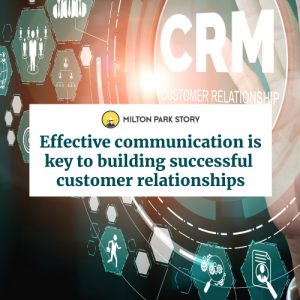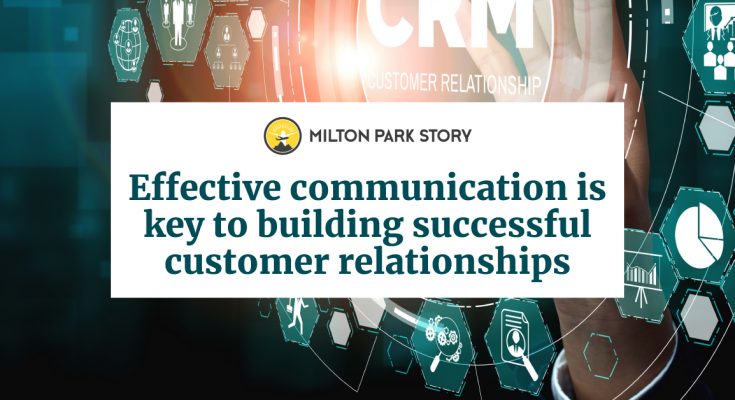“One cannot always comply; one may, however, always talk obligingly,” says Sri Sathya Sai Baba, an Indian spiritual teacher, elaborating on the difficult role of corporate communication in today’s businesses.
As the old adage goes, the customer is king! He believes he is a king, at least until the not-so-charitable mandarins of marketing let him know and make him aware, rather cruelly for him, that he is one of the many millions who feel that way but aren’t. The same mandarins, on the other hand, reluctantly admit that a satisfied customer is a brand’s success, while a thrilled customer is a brand’s ambassador. These pillars are precisely what the customer relationship management paradigm – commonly abbreviated as CRM – is built on. In this paradigm, the consumer is in a precarious situation.
Often, in the midst of concentrated CRM efforts, a corporation overlooks the most basic aspect of the notion… connection! Traditional marketing philosophies have long prioritized gaining new clients above keeping current ones. This has steadily changed over the last decade, thanks to more competition and a wider range of products. The current marketing trend is to retain rather than ‘gain.’ Because retention leads to expansion, and expansion leads to satisfaction.
In today’s marketing, the customer is considered as a naughty sprite rather than a monarch. He’s nearly accused of making a brand dance to his whims and wishes. While purists think that customers require brands and vice versa, modernists contend that customers require a brand, any brand, as long as the brand is a willing genie. Brand communication methods are shaped by this unbalanced balance. Positioning is no longer viewed as a marketing technique but rather as an unpleasant proposition to pique a customer’s interest. It’s no longer about the brand, the product, the benefit, or the feature; it’s about the consumer.
So, what does it take to build a relationship between a company and its customers? The brand’s personality must shine through in order to establish a genuine connection (Michael C Gray, 2006). It will no longer be a brand and a customer, but simply ‘you’ and ‘I’… a well-developed partnership leads to ‘we,’ which might be a satisfying condition for both a brand and a customer.
People prefer to do business with people rather than institutions or brands, according to social researchers. This means that corporate communication must serve as a vital link in the development and maintenance of a positive relationship between both parties. Newsletters, fax messages, audio broadcasts, blogs, sales letters, emails, and other forms of frequent communication are all technically possible.
 The following aspects of a connection are reflected in customer communication.
The following aspects of a connection are reflected in customer communication.
- A strong culture
- A positive identity
- A logical worldview
- A genuine sense of community
Effective corporate communication develops a suitable and professional relationship with the customer, including swift, responsible channels of two-way contact, even if it does not provide instant gratification or affection. Business communication is all about managing perceptions and ensuring that a favorable corporate image is produced by effective and timely transmission of information, providing a smooth and affirmative interaction with all customers at all times.
Whether it’s a corporation, a company, a research institution, a non-governmental organization, or a public utility, all of them must have a positive image and reputation in the eyes of their customers. In today’s world, where there is more competition, more access to information, and a media explosion, reputation management is more important than ever. As a result, while engaging with clients, corporate communications has taken on a more important and professional function.
Corporate communications have evolved from a science and art of ‘wining and dining the client’ to a science and art of perception management. The idea of managing client relationships is as old as commerce itself, but the focus has always been on selling goods and services (Kotler, Philip, Introduction to Marketing Principles). The face of business has altered as a result of globalization and the Internet. Customers now have a wide range of options, and they are also becoming far more knowledgeable and demanding. The customer’s power has genuinely shifted. With this scenario in mind, most businesses know that they need to be more attentive to their clients.
Companies are scrambling to find new ways to manage their connections successfully, not only to attract new customers but also to keep the ones they already have. According to a Harvard Business Review study by Reichheld & Sasser, by maintaining just 5% or more of their existing clients, some businesses can increase their profitability by nearly 100%.
Customers show their gratitude in a variety of ways. When they’re satisfied, they usually don’t say anything and keep coming back to buy or use more. Only half of the story is satisfaction measurement. Customers’ expectations or the value they assign to certain brand overtures must also be determined; otherwise, resources may be spent boosting satisfaction levels for items that do not matter. It is more difficult to measure expectations or importance than it is to quantify satisfaction. Many people are unaware of or unwilling to admit what is significant, even to themselves.
Consumers do not spend time justifying their actions; their opinions shift, and they may be unable to articulate or admit to the complexities of the purchasing decision. A customer satisfaction index captures a moment in time. People’s opinions vary with time, and firms’ performance in delivering customer satisfaction changes as well. Satisfaction must be measured on a regular basis. (White paper on Customer Satisfaction Surveys, B2B International Ltd., Paul & Nick Hague.)
Even when specialists talk about CRM, it’s virtually usually in the context of marketing, sales, and business growth. CRM is rarely thought of as an ‘objective’ that every company should strive for. It is frequently viewed as a tool that any organization could utilize. There are numerous distinctions. CRM isn’t an IT function, either. CRM is frequently a function of communication, whether conducted directly by the company, through an intermediary such as a public relations firm, or through the media.
Successful CRM practices are about competing in the relationship dimension—not as an alternative to having a competitive product or a reasonable price—but as a differentiator in terms of ‘feelings for the customer,’ as abstractly – and often outrageously – romantic that may seem. In the long term, it’s a far more sustainable connection if brands can gain an advantage based on how people feel about the brand. This “feeling for a brand,” as brand theorists prefer to put it, is proportionate to a company’s communication efforts, both written words and spoken sentences.
When you tie it to the firm’s communication strategy, you’ll have a direct line of contact between the company and its customers. The relationship that a brand has with its customers is a vital aspect of any CRM strategy. The word ‘client’ may seem a little out of place here because it indicates that the person is ‘outside’ of a connection. Communication is how any relationship is expressed and developed.
Almost always, marketers try to understand customers through the lens of marketing, as people who need to be ‘offered’ something in order to keep their allegiance. This naturally elevates them to a moral (and commercial) high ground, allowing them to look down on unfortunate clients as recipients of their generosity. This is how up and down power positions are expressed in communication. And in a partnership between equals, power is not distributed in a hierarchical manner. The consumer is sometimes painted as a king, or as an excessively greedy pauper, by the archaic social attitude, which refuses to position him on an even keel with a brand – and vice versa.
CRM is a straightforward procedure since creating a relationship is straightforward. Nowhere is comprehension more profound than when it comes to human emotions… but organizations have strangely disregarded these same human emotions when communicating with their customers.
What is the definition of a relationship? When is a relationship between two entities established? What role does corporate communication play in the formation, maintenance, and fulfillment of such relationships? A relationship can simply be defined as a form of connection that exists between persons who are biologically or emotionally linked to each other and have social or economic transactions with each other. Unfortunately, when commercial returns on investments are addressed, all pretenses of dealing with relationships that often require simplicity, empathy, believability, and sincerity vanish. That is exactly what communication is all about: communicating with customers rather than with each other.
Researchers have long argued that it is more important to consider what a brand thinks of its consumers than what a brand thinks of its customers in order to understand brand-customer relationships. Marketers work hard to improve customer happiness only to discover that customers prefer their competition. What causes this to happen? Investments in customer communication, which logically appears to be the most important component of a relationship, have been the most ignored sector in most firms, according to research.
The fact that 65 percent of all customer service tasks are outsourced to business processing units is the basis for this claim (BPUs). That means the brand doesn’t deal directly with customer contacts and questions unless they’re at a specific level. This is equivalent to requesting a buddy to speak to your representative on your behalf about anything you want to say, including personal matters, and only speak directly if it’s something serious! In the first instance, this approach is marketing-driven and one-sided. There are also many brand loyalty programs that marketers are attempting on their own without the backing of several other relevant and connected techniques. There is a unique need for marketers to comprehend the significance of customer communication rather than viewing it solely through the lens of public relations, advertising, or other well-known corporate types of communication.
Corporate communication strategies are frequently designed to act as a link between stakeholders, to justify policies and decisions, to deliver business strategies, to inform and persuade, and, of course, to emphasize that the company is committed to putting the interests of its customers first, almost as an afterthought!
As a result, corporate communications is nearly always thought of as a method for establishing, maintaining, nurturing, and extending commercial connections with clients. As GE’s former CEO Jack Welch put it, “this is sadly a bureaucratic notion.” “Bureaucracies enjoy concentrating on themselves. They don’t despise customers; they just don’t find them as fascinating as they do.” And it’s reflected in the communication.
In his book ‘Customers Are People: The Human Touch,’ author Jon McKean claims that “70 percent of customer decision-making is based on how customers are treated” in competitive markets when customers have a choice between similar items and pricing. “However, over 80% of customer initiatives are focused on selling to consumers better’ through superior items, prices, and promotions, rather than investing more resources in serving customers better,” McKean continues. What is the finest way to treat a person? Simply by being spoken to in a more pleasant manner.
The challenge that is staring companies in the face is, “How can I make a consumer loyal?” When businesses speak of relationships in which consumers have actual options, they are genuinely attempting to be the best suitor for the customer, ‘as the customer sees it,’ not ‘how they want the customer to perceive it.’ For years, Reichheld and other loyalty experts have studied this topic and come to the conclusion that customer behavior and perceptions of the value of the relationship that exists between the brand and himself, which is the net result of the economic and psychological value that the customer receives from the brand, drive relationships.
Customers’ emotional moods, according to psychologists, determine nearly half of the value they feel from their purchases. “Value is created every time a customer is made to feel welcome, significant, and valued,” says Jim Barnes, author of “Secrets of Customer Relationship Management: It’s All About How You Make Them Feel.”
After reasonably agreeing that the most important aspects of CRM are relationships and how customers perceive relationships differently and uniquely based on their distinct behavior and personality, it is also critical to emphasize that corporate communication is the primary driver of any relationship. Communication is all about expressing oneself, as the major Indian telecom firm AirTel displays in its advertising.
A customer’s, product’s, policy, and strategy’s aggregate interactive experience shapes a brand’s identity. That is why it is critical to establish a brand-customer relationship. Either a brand creates a consumer experience or a customer experience is developed despite the brand. The brand must develop a compelling identity with the customer and have a true value offer in order to build a successful relationship. The brand must be able to rely on the client’s perspective, appreciate the viewpoint, and communicate effectively. Many brands make the mistake of not taking the time to consider how they should communicate their brand identity. A strong brand strategy is, without a doubt, incomplete without a solid communications strategy. To build meaningful relationships and a long-term competitive advantage, the business must be aligned in ways that anticipate and fulfill consumers’ emotional expectations at every touchpoint.
As the customer would like to see, effective customer communication clearly displays the brand’s functional, emotional, and self-expressive benefits. When compared to competitors, it is given in a superior or unique manner. A sequence of contacts with a company shapes the customer experience.
Barriers to efficient communication, such as frames of reference, value judgments, selective listening, filtering, and distrust (all between sender and receiver), impede communication systems and messages, according to Jonathan Hardcastle. These can be overcome by sending clear, full, and specific communications that are straight from the heart,’ to put it romantically. Having a positive image can be enhanced by demonstrating love and devotion, explaining objectives, being reliable and active, and displaying warmth and friendliness. Soliciting and offering specific feedback can also improve the effectiveness of communication between partners, which is what brands should consider their customers to be.
The capacity to ask inquiries and obtain properly satisfactory replies from brand representatives is one of the essential consumer happiness components. An effective consumer communication plan, according to Hardcastle, includes gathering information, finding motives, providing incentives, eliciting involvement, checking to understand, commencing the thought process, generating agreements, and refocusing attention. As a result, a brand’s active listening abilities aid in the development of an intimate and empathic relationship with customers.
The other most significant part is the brand’s and consumers’ delicate non-verbal communication, which is useful for interpreting customers’ underlying emotions and attitudes as well as reinforcing a brand’s vocal statements. Understanding subtle communication can help you improve your brand’s interaction with your customers.
Added to this are rising technological standards and devices that provide the communication process a competitive edge. Unfortunately, excessive reliance on technology and automation has harmed client relationships. While brands talk about relationships – a concept usually associated with living things in general and humans in particular – the overuse of technology has resulted in a dissociation that has separated the customer and the brand. This dichotomous condition must be recognized by both the brand and the client because communication is all about power positions, and it is critical to understand that power positions in a relationship are balanced.
Finally, because of the increasing complexity and turbulence of the business environment, as well as the related growth in research knowledge about customer behavior patterns, managers in the twenty-first century must prioritize four themes: the need to manage change challenges, function in a global environment, be sensitive to diversity among people, and act ethically.
Dialogue is the final component that bonds a customer to your brand in a long-term relationship. Your company’s brand isn’t a one-dimensional, hermetic image that it displays to the outside world. Rather, it’s a constant conversation in which you pay attention to your customers, understand what they’re saying, and respond by changing your value proposition and expanding your business to meet their needs. Because of the customer, you exist. The cornerstone of good CRM is selflessness.
As a result, any corporate communication effort should primarily focus on three aspects: understanding relationships, knowing consumer responses to relationship overtures, and understanding (and creating) the function of communication in effective and enduring customer relationships. Contact Uhaul Customer Service here.




